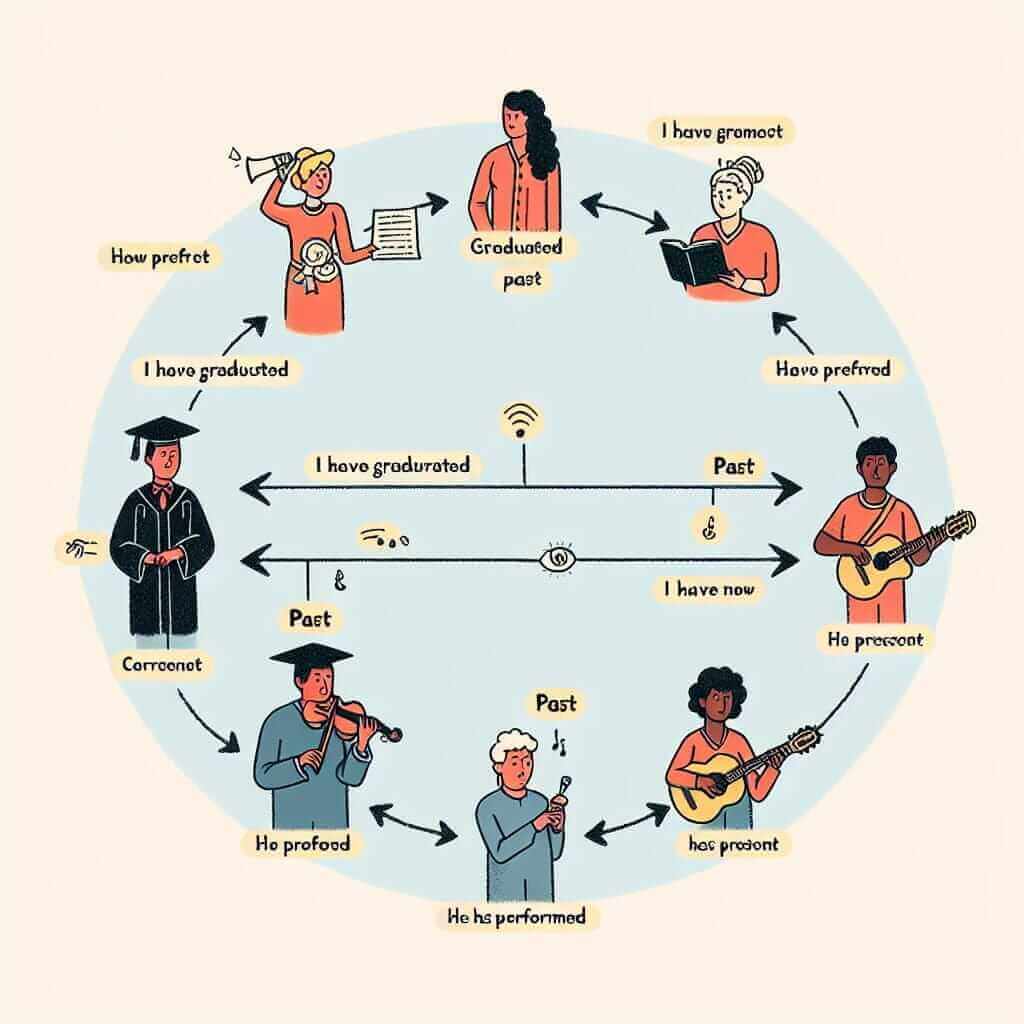The present perfect tense is a crucial grammatical structure in English, frequently appearing in the IELTS exam. Mastering its use is essential for achieving a band score of 7 or higher.
Let’s look at a few examples of how the present perfect tense might appear in different sections of the IELTS exam:
Speaking Part 1:
- Examiner: “Tell me about a hobby you enjoy.”
- You: “I’ve been playing the guitar for five years now, and I’ve always found it very relaxing.” (This response highlights the duration of an action that began in the past and continues in the present.)
Writing Task 1 (describing a graph):
- “The graph illustrates that the number of international students has increased dramatically over the last decade.” (This sentence emphasizes a trend that began in the past and its effect on the present.)
Listening Section 3:
- “Professor: ‘…and that’s why the government has implemented new environmental regulations.'” (You may need to understand the impact of a past action on the present situation.)
Understanding the Present Perfect Tense
The present perfect tense connects the past to the present. We use it to describe:
- Actions that started in the past and continue to the present.
- Past experiences with relevance to the present.
- Past actions with results in the present.
Form and Structure
The present perfect tense follows a simple formula:
Subject + have/has + past participle
Here’s a breakdown for affirmative, negative, and interrogative forms:
| Form | Structure | Example |
|---|---|---|
| Affirmative | Subject + have/has + past participle | I have visited Paris twice. |
| Negative | Subject + have/has + not + past participle | She has not finished her homework yet. |
| Interrogative | Have/Has + subject + past participle | Have you seen the new Marvel movie? |

Using the Present Perfect Tense in the IELTS Exam
Speaking
The present perfect tense is particularly useful in the Speaking section when discussing experiences, changes, or events that have a connection to the present.
- “I’ve always been interested in photography.” (Experience)
- “My hometown has changed significantly since I was a child.” (Change)
- “I’ve recently completed a course in digital marketing.” (Recent event)
Writing
In Writing Task 1, use the present perfect to describe trends or changes shown in graphs, charts, or diagrams.
- “The consumption of fast food has risen steadily over the past two decades.”
- “There has been a sharp decline in the number of smokers in the country.”
In Writing Task 2, the present perfect tense can be used to express experiences, make arguments, or present evidence.
- “Technology has revolutionized the way we communicate.”
- “Many people have argued that social media has a negative impact on young people.”
Listening and Reading
Understanding the present perfect tense is essential for comprehending both spoken and written English in the IELTS exam. Pay attention to its use in context to identify:
- The relationship between past events and the present situation.
- The duration of actions or states.
- The completion of actions with present relevance.
Tips for Mastering the Present Perfect Tense
- Pay attention to time expressions: Words like since, for, already, yet, recently, ever, never often signal the use of the present perfect tense.
- Focus on the connection to the present: Remember that the present perfect tense always relates to the present in some way, even if it’s describing an event that started in the past.
- Practice, practice, practice: Regularly using the present perfect tense in speaking and writing will solidify your understanding and improve your fluency.
Common Mistakes to Avoid
- Using the simple past instead of the present perfect: Remember, the present perfect emphasizes the connection to the present, while the simple past describes completed actions in the past.
- Incorrect: “I lived in London for two years.”
- Correct: “I have lived in London for two years.” (This implies you still live in London.)
- Incorrect use of ‘for’ and ‘since’:
- Use ‘for’ to indicate a duration of time (for five years).
- Use ‘since’ to specify a starting point in the past (since 2010).
- Overusing the present perfect continuous: While related, the present perfect continuous emphasizes the duration of an action. Choose the tense that best suits the context.
By understanding the nuances of the present perfect tense and practicing its application, you can enhance your grammatical accuracy and boost your overall IELTS score. For further insights into the use of present perfect simple and continuous tenses, refer to this helpful resource: [Insert link to the IELTS.net article with the anchor text “present perfect simple and continuous tenses” here].